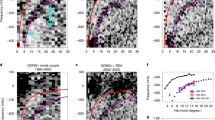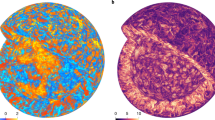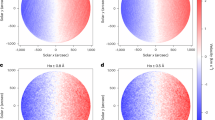Abstract
The recent observation1 of rotational splitting of the non-radial p modes of l = 1 and l = 2 (with it n∼20) of the 5-min global oscillation of the Sun was interpreted in terms of rotational splitting associated with a rapid rotation of the solar interior. The precise value deduced for the angular velocity Ω of the interior depends on the assumed variation of Ω with depth and on the weighting function. Thus with a weighting function2 of the form
&Ω̄=∫Ω(r)/V(r) dr ∫dr/V(r) (1)
where V(r) is the local velocity of sound at radius r, one obtains values of Ωcore/Ωsurface ranging from 2 to 9 as the radius at which Ω, assumed to be constant for smaller r, ranges from 0.6 to 0.15 of the solar radius. Such a weighting function proportional to the time the wave spends at any particular radius seems very plausible for the effect of any parameter, be it angular velocity or magnetic field, on the propagation of nearly plane waves as they bounce between the centre and the surface. Here I attempt to correlate the size of the observed rotational splitting with the enigmatic 12.2-day variation in the measurement of solar oblateness discovered by Dicke3 previously4 and to interpret the observed near equality of the amplitudes of the m- components of the l = 1 and l = 2 rotationally split modes. This leads to the first empirical evidence that an asymmetric magnetic rotator with megagauss magnetic fields exists in the interior of the Sun. It also suggests that the magnetic energy of young stars is a sizeable fraction of their gravitational energy.
This is a preview of subscription content, access via your institution
Access options
Subscribe to this journal
Receive 51 print issues and online access
$199.00 per year
only $3.90 per issue
Buy this article
- Purchase on SpringerLink
- Instant access to full article PDF
Prices may be subject to local taxes which are calculated during checkout
Similar content being viewed by others
References
Claverie, A., Isaak, G. R., McLeod, C. P., van der Raay, H. B. & Roca Cortes, T. Nature 293, 443–445 (1981).
Christensen-Dalsgaard, J. & Gough, D. O. Preprint (Univ. Cambridge, 1981).
Dicke, R. H. Sol. Phys. 47, 475–515 (1976).
Dicke, R. H. & Goldenberg, H. M. Phys. Rev. Lett. 18, 313–316 (1967).
Allen, C. W. Astrophysical Quantities 3rd edn (Athlone, London, 1973).
Fricke, K. J. & Kippenhahn, R. A. Rev. Astr. Astrophys. 10, 45 (1972).
Goosens, M. Astrophys. Space Sci. 43, 9–18 (1976).
Goosens, M. Astrophys. Space Sci. 44, 397–404 (1976).
Cowling, T. G. Mon. Not. R. astr. Soc. 105, 166–174 (1945).
Mestel, L. & Takhar, H. S. Mon. Not. R. astr. Soc. 156, 419–436 (1972).
Dicke, R. H. Astrophys. J. 228, 898–902 (1979).
Chandrasekhar, S. & Fermi, E. Astrophys. J. 118, 116–141 (1953).
Dicke, R. H. Astrophys, J. 171, 331–362 (1972).
Schatzman, E. Ann. Astrophys. 25, 18–29 (1962).
Dicke, R. H. Nature 202, 432–435 (1964).
Mestel, L. Mon. Not. R. astr. Soc. 140, 177–196 (1968).
Ezer, D. & Cameron, A. G. W. Astrophys. Lett. 1, 177 (1968).
Bahcall, J. N., Bahcall, N. A. & Ulrich, R. K. Astrophys. Lett. 2, 91 (1968).
Roxburgh, I. W. Pleins Feux Sur La Physique Solaire, 21–23 (CNRS, Paris, 1978).
Dicke, R. H. New Scient. 83, 12–14 (1979).
Brookes, J. R., Isaak, G. R. & van der Raay, H. B. Nature 259, 92–95 (1976).
Severny, A. B., Kotov, V. A. & Tsap, T. T. Nature 259, 87–89 (1976).
Chandrasekhar, S. & Limber, D. N. Astrophys J. 119, 10–13 (1954).
Author information
Authors and Affiliations
Rights and permissions
About this article
Cite this article
Isaak, G. Is the Sun an oblique magnetic rotator?. Nature 296, 130–131 (1982). https://doi.org/10.1038/296130a0
Received:
Accepted:
Issue date:
DOI: https://doi.org/10.1038/296130a0
This article is cited by
-
Is the Sun a Magnet?
Solar Physics (2017)
-
Variation of low-order acoustic solar oscillations over the solar cycle
Nature (1990)
-
Is there an unusual solar core?
Nature (1986)
-
Solar physics: What causes the solar cycle?
Nature (1986)
-
Oblateness of the Sun in 1983 and relativity
Nature (1985)



